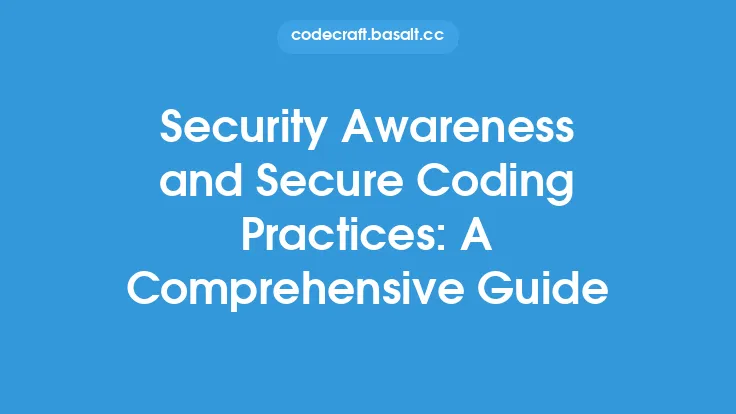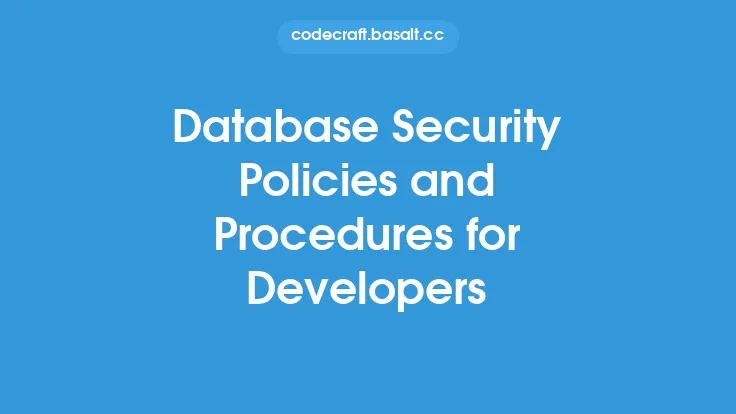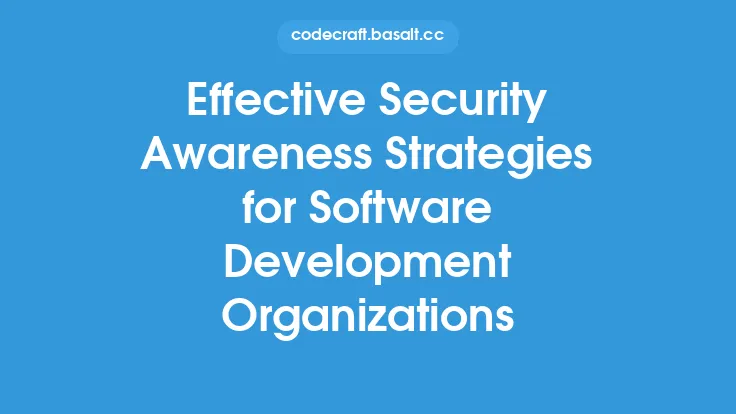As software developers, it's essential to understand the importance of security awareness in the development process. Security awareness is not just about following best practices or guidelines; it's about having a mindset that prioritizes security in every aspect of development. In this article, we'll delve into the essential principles and guidelines that developers should follow to ensure the security of their applications and systems.
Introduction to Security Principles
Security principles are the foundation of security awareness. These principles provide a framework for developers to follow when designing, developing, and deploying software applications. Some of the key security principles include:
- Confidentiality: Protecting sensitive data from unauthorized access.
- Integrity: Ensuring that data is accurate, complete, and not modified without authorization.
- Availability: Ensuring that data and systems are accessible and usable when needed.
- Authentication: Verifying the identity of users and systems.
- Authorization: Controlling access to data and systems based on user identity and permissions.
Developers should consider these principles when designing and developing software applications. For example, when handling sensitive data, developers should ensure that it's encrypted both in transit and at rest. They should also implement access controls to restrict access to authorized personnel only.
Secure Coding Practices
Secure coding practices are essential for preventing common web application vulnerabilities such as SQL injection and cross-site scripting (XSS). Some of the key secure coding practices include:
- Input validation: Validating user input to prevent malicious data from entering the application.
- Error handling: Handling errors and exceptions in a way that doesn't reveal sensitive information.
- Secure data storage: Storing sensitive data securely, such as using encryption and secure protocols.
- Secure communication: Using secure communication protocols, such as HTTPS, to protect data in transit.
Developers should also follow secure coding guidelines, such as the Open Web Application Security Project (OWASP) Secure Coding Practices. These guidelines provide detailed information on how to prevent common web application vulnerabilities.
Threat Modeling and Risk Assessment
Threat modeling and risk assessment are critical components of security awareness. Threat modeling involves identifying potential threats to an application or system, while risk assessment involves evaluating the likelihood and impact of those threats. Developers should conduct threat modeling and risk assessment throughout the development process, from design to deployment.
Some of the key threat modeling and risk assessment techniques include:
- STRIDE: Identifying threats based on the STRIDE model, which includes Spoofing, Tampering, Repudiation, Information disclosure, Denial of service, and Elevation of privilege.
- DREAD: Evaluating the risk of threats based on the DREAD model, which includes Damage potential, Reproducibility, Exploitability, Affected users, and Discoverability.
Developers should use these techniques to identify potential threats and evaluate their risk. They should then implement controls to mitigate those risks, such as input validation and access controls.
Secure Development Lifecycle
The secure development lifecycle (SDLC) is a framework for integrating security into the development process. The SDLC includes several phases, including:
- Requirements: Defining security requirements and guidelines.
- Design: Designing the application or system with security in mind.
- Implementation: Implementing the application or system with secure coding practices.
- Verification: Verifying the security of the application or system through testing and validation.
- Maintenance: Maintaining the security of the application or system through updates and patches.
Developers should follow the SDLC to ensure that security is integrated into every phase of the development process. They should also conduct regular security testing and validation to identify vulnerabilities and weaknesses.
Common Web Application Vulnerabilities
Common web application vulnerabilities, such as SQL injection and XSS, can have significant security implications. Developers should be aware of these vulnerabilities and take steps to prevent them. Some of the key common web application vulnerabilities include:
- SQL injection: Injecting malicious SQL code into a web application's database.
- XSS: Injecting malicious code into a web application's user interface.
- Cross-site request forgery (CSRF): Tricking a user into performing an unintended action on a web application.
- Buffer overflow: Overwriting a buffer with more data than it can hold, potentially allowing an attacker to execute malicious code.
Developers should use secure coding practices, such as input validation and output encoding, to prevent these vulnerabilities. They should also conduct regular security testing and validation to identify vulnerabilities and weaknesses.
Security Testing and Validation
Security testing and validation are critical components of security awareness. Developers should conduct regular security testing and validation to identify vulnerabilities and weaknesses. Some of the key security testing and validation techniques include:
- Penetration testing: Simulating an attack on an application or system to identify vulnerabilities.
- Vulnerability scanning: Scanning an application or system for known vulnerabilities.
- Code review: Reviewing code for security vulnerabilities and weaknesses.
Developers should use these techniques to identify vulnerabilities and weaknesses. They should then implement controls to mitigate those risks, such as input validation and access controls.
Conclusion
Security awareness is essential for developers to ensure the security of their applications and systems. By following the essential principles and guidelines outlined in this article, developers can prevent common web application vulnerabilities and ensure the confidentiality, integrity, and availability of sensitive data. Remember, security awareness is not just about following best practices or guidelines; it's about having a mindset that prioritizes security in every aspect of development. By integrating security into every phase of the development process, developers can ensure the security of their applications and systems, and protect against common web application vulnerabilities.





